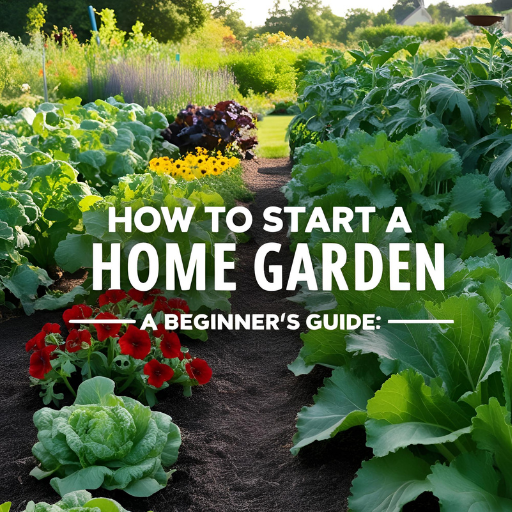Creating a home garden is a beautiful and rewarding experience that not only brings nature into your daily life but also helps reduce stress, promotes sustainability, and even improves your diet if you grow your own food. If you’re just getting started with gardening, it can feel overwhelming at first—but don’t worry! This guide will walk you through everything you need to know to start your own garden from scratch, whether you have a backyard, a balcony, or just a few pots on a windowsill.
Why You Should Start Gardening at Home
Before we get into the “how,” let’s talk about the “why.” Gardening is more than just a hobby. It offers a wide range of benefits:
-
Physical Activity: Gardening gets you moving and helps you stay active.
-
Mental Well-being: Being close to plants has been proven to reduce stress and improve mood.
-
Sustainability: Growing your own herbs or vegetables helps reduce your carbon footprint.
-
Fresh Produce: You get to enjoy fresh, organic herbs, fruits, and veggies right from your home.
Step 1: Assess Your Space
You don’t need a huge yard to start gardening. Evaluate the space you have:
-
Backyard: You can create beds, use containers, or even try raised garden beds.
-
Balcony: Focus on potted plants, hanging planters, and vertical gardening techniques.
-
Windowsill: Perfect for herbs, small succulents, or leafy greens.
Even small areas can be turned into thriving green spaces with the right planning.
Step 2: Understand Your Sunlight
Plants need sunlight, but different plants require different amounts:
-
Full Sun: 6 or more hours of direct sunlight per day.
-
Partial Sun/Shade: 3 to 6 hours of sunlight per day.
-
Full Shade: Less than 3 hours of direct sunlight per day.
Spend a day observing how sunlight moves through your space. This will help you choose the right plants for the right locations.
Step 3: Choose the Right Plants
Beginners should start with easy-to-grow plants. Here are some great starter options:
For Vegetables:
-
Lettuce
-
Radishes
-
Cherry Tomatoes
-
Green Beans
-
Zucchini
For Herbs:
-
Basil
-
Parsley
-
Mint
-
Thyme
-
Chives
For Flowers:
-
Marigolds
-
Zinnias
-
Petunias
-
Calendula
-
Sunflowers
Make sure you check the growing season in your region so you know what to plant and when.
Step 4: Get the Right Tools
You don’t need expensive tools to start gardening, but a few basics will make your life much easier:
-
Hand trowel
-
Pruning shears
-
Watering can or hose with a spray nozzle
-
Gardening gloves
-
Garden fork
-
Containers or raised beds (if needed)
You can always expand your collection as you gain experience.
Step 5: Prepare the Soil
Good soil is the foundation of a healthy garden. If you’re planting in the ground, test your soil’s pH and nutrient levels. You can buy a simple soil test kit online or at a gardening store.
For containers or raised beds, use high-quality potting mix. Consider adding compost to enrich the soil and improve moisture retention.
Step 6: Start Planting
Once your soil is ready and you’ve picked your plants, it’s time to get them in the ground (or containers). Follow these tips:
-
Spacing: Give each plant enough room to grow.
-
Depth: Don’t plant too shallow or too deep. Check seed packets or labels.
-
Watering: Water thoroughly after planting, and keep the soil consistently moist.
-
Labeling: Use plant markers to remember what’s where.
If you’re starting from seeds, be patient. Germination can take a few days to a few weeks depending on the plant.
Step 7: Create a Watering Routine
Plants need water, but too much or too little can harm them. As a beginner, follow these general rules:
-
Water in the early morning or late afternoon to avoid evaporation.
-
Stick your finger into the soil—if it’s dry 1–2 inches down, it’s time to water.
-
Use a watering can with a fine spout or a hose with a spray setting to avoid damaging delicate plants.
Step 8: Learn About Pest Control
It’s normal to encounter some pests, but there are ways to handle them naturally:
-
Neem Oil: A natural pesticide that’s safe for most plants.
-
Diatomaceous Earth: Helps control soft-bodied insects like slugs and aphids.
-
Companion Planting: Some plants naturally repel pests. For example, marigolds deter aphids and nematodes.
Try to avoid chemical pesticides, especially if you’re growing edible plants.
Step 9: Maintain Your Garden
Gardening is not a one-time task. Here are some things you’ll need to do regularly:
-
Weeding: Remove weeds that compete with your plants for nutrients.
-
Pruning: Trim dead or overgrown parts to promote healthy growth.
-
Fertilizing: Every few weeks, depending on the plant, add compost or natural fertilizers.
-
Mulching: Helps retain moisture and suppress weeds.
Make it part of your routine—gardening 10–15 minutes a day goes a long way.
Step 10: Track Your Progress
Keep a gardening journal or take photos of your progress. Note what works, what doesn’t, and when you planted different things. This will help you become a better gardener over time.
Apps like “Plant Diary” or even a simple notebook can help you stay organized and motivated.
Enjoy the Fruits (and Flowers) of Your Labor
Gardening teaches patience, care, and appreciation for nature. Whether you’re harvesting your first cherry tomato or watching a flower bloom, each small success feels incredibly rewarding.
And remember, it’s okay to make mistakes! That’s how you learn. With each season, your knowledge and confidence will grow—just like your garden.
